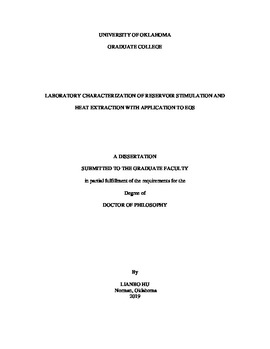| dc.description.abstract | Enhanced or engineered geothermal systems (EGS) could enable extraction of significant geothermal energy from hot relatively dry rock reservoirs. However, issues related to reservoir creation in different type of rocks and stress conditions, reservoir monitoring during reservoir creation and consequent production, better knowledge of the fluid/heat flow in the induced fracture, field management and optimization need be addressed before successful commercial development. As an effort to help solve these essential questions, a novel lab-scale EGS test system was developed to perform EGS simulation experiments on rock blocks under high pore pressure/elevated temperature and representative in-situ stress regimes while simultaneously recording Acoustic Emission (AE), self-potential (SP), temperature/pressure and tracers to characterize the reservoir creation, heating mining and flow characteristics of the system. The tests were performed on the 330 mm × 330 mm ×330 mm cubic igneous rock blocks. Two kinds of igneous rocks with different texture and permeability were tested with one injection hole and four producers (five-spot pattern). The great potential of EGS was demonstrated by the fact that about 50 watts of power was obtained by fluid flowing through the induced fracture with length of 8.9 cm and rock temperature less than 80oC.
Analysis of the test results sheds light on the use of acoustic emission for better understanding of hydraulic fracturing. Also, self-potential analysis indicates SP response was mainly controlled by electrokinetic coupling and the impact of thermoelectric coupling on recorded SP is negligible as demonstrated in some field observations and modeling while the fluid concentration (salinity) has a great influence on the SP response compared with temperature gradient when the concentration contrast between the injection fluid and the pore fluid is large due to the streaming potential coefficient reduction by the high concentration liquid. The heat circulation test shows that it is the effective fracture area instead of the total fracture area that controls the heat mining in EGS and thus the distance between injection/production wells or the location of the producer(s) and flow path tortuosity need be optimized to increase the effective heat exchange area in reservoir stimulation practice and the heat mining should be operated in a proper way to avoid well competition when multiple producers are connected to the same injection well by natural/man-made fractures. Excessive fracture propagation and high injection pressure was avoided during circulation tests by increasing the injection rate step by step. The cooling effect of the rock matrix i.e., increased fracture conductivity and lowering of the injection pressure is clearly manifested in the circulation experiments.
As the first lab-scale tracer test on EGS, the obtained result was promising. The existing of two linear tracer tail was observed in Sierra White granite test and tracer result does show a good correlation between hydraulic conductivity and the tracer concentration response. The impact of rock texture was observed. What’s more, the test result could provide some useful guide for future lab-scale tracer test deign. Low permeability rock is recommended for tracer test to minimize leakage of tracer fluid into the rock matrix and also improve the fluid recovery. Low injection rate will increase the tracer time the in the fracture while proper tracer candidate with low-concentration detectability is required.
Since the in-situ permeability of most of the dry hot rocks is not high enough to support the water injection with sufficient rate, reservoir stimulation by hydraulic fracture is usually applied. Considering the comment presence of natural fractures in the underground rocks, it is of importance to analyze the interaction between the hydraulic fracture and natural fracture. Analog experiments were conducted to investigate the interaction between a natural fracture and a hydraulic fracture with focus on slippage on the natural fracture or a bedding plane discontinuity due to an approaching hydraulic fracture. The tests were conducted on 101.6 mm diameter cylinder samples with a horizontal wellbore. The test materials included PMMA, shales, and Sierra White granite. Injection pressure, deviator stress, acoustic emission and the sample deformation are monitored during the test. In all the reported tests, the displacement calculated from the measured strain across the joint clearly shows a jump subsequent to pressure breakdown, and is accompanied by increased AE activity and decreased deviator stress. The displacement jump (slippage) across the joint with decreased deviatoric stress and AE activities on the joint from show that the hydraulic fracture caused slip of the saw-cut fractures even before reaching them. Analysis of the data clearly shows the occurrence of slippage on the joint in response to an approaching hydraulic fracture. The slippage due to the increased pore pressure on the natural fracture was also observed. Before the induced fracture reached the natural fracture, different degree of slippage (0.085mm ~ 0.11 mm) was obtained from these tests with various amount of deviator stress drop (0.14 MPa~ 0.6 MPa). Expectedly, the degree of shear slip varies with natural fracture dip, and friction angle and the differential stress. It is also observed that the pore pressure increase on the natural fracture by the encroaching hydraulic fracturing triggered larger slip on the natural fracture. | en_US |
